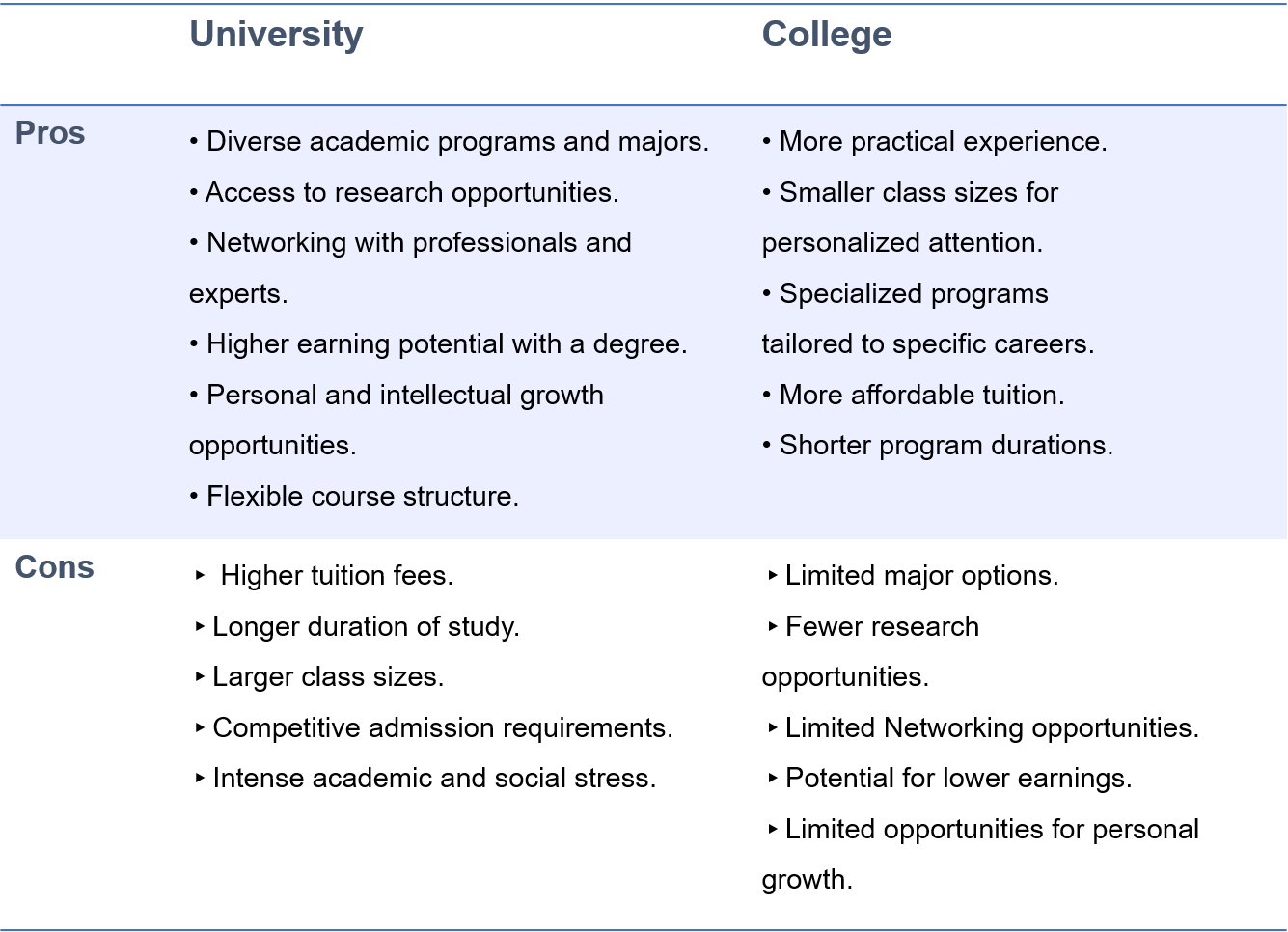
Applying to Canadian universities begins with filling out an online application form, either directly on the university’s website or through centralized systems like the Ontario Universities’ Application Centre (OUAC) for Ontario schools.
You’ll need to submit official transcripts, standardized test scores (if required), supplementary materials like personal statements or essays, and proof of English proficiency if you’re an international student.
Adhering to deadlines, typically between January and March for September intake, is essential to ensure your application is considered. Once submitted, students can track their application status online and anticipate admission decisions, usually announced in late spring.
Follow these steps below to successfully navigate the Canadian university application process and secure your spot.
TABLE OF CONTENTS

Step 1: Determine Your Educational Goals
Research Universities vs. Colleges
Universities tend to focus on academics and research, ideal if you’re considering further studies or research careers. Colleges are more hands-on and career-focused, suited for those looking to enter the workforce quickly.

Utilize Rankings and Resources
Use tools like Maclean’s University Rankings and university websites to compare programs and institutions. Additionally, student forums are valuable resources where you can connect with current students and alumni to gain insights about the universities, programs, and campus life.

List Priorities
Whether the university or the major is more important depends on your goals, interests, and career plans—there’s no single right answer. Ideally, both matter: a good university and a major that aligns with your passion and future career.
However, if you have to choose, the major might be the better focus. Your interests and skills will keep you motivated and play a big role in long-term success. In the end, it’s about what makes you happy and where you see yourself in the future.


Step 2: Gather Academic Documents
Request Transcripts
Domestic students need high school transcripts for all three years, and some schools may require provincial exam scores. Contact your high school to request official transcripts. International students must provide high school transcripts translated into English or French and notarized.
Check Requirements
Visit each university’s admissions page to find out specific document requirements. To find the relevant information, look for the ‘Admissions’ or ‘Apply’ sections in the university website’s navigation bar. Usually, these sections will have a link labeled ‘Requirements’ or ‘Documents Needed.’
Use Credential Services
If your transcripts need to be evaluated for equivalency, consider using services like WES (World Education Services). Utilizing WES can help ensure that your academic credentials are accurately understood and accepted by Canadian universities.
Prepare Diplomas
It’s important to include your high school diploma or a letter from your school that confirms your expected graduation date. Request these documents well in advance to avoid any delays in your application process.
Standardized Test Scores
If you’re in an international curriculum, you may need to submit standardized test scores like the SAT, ACT, CAEL, or AP, depending on the university’s requirements. After taking the exams, request that your scores be sent directly to the universities you’re applying to. This can usually be done through the testing agency’s website.
Step 3: Obtain Language Test Scores
Language proficiency is key for non-native speakers. Register for tests like IELTS or TOEFL 6-12 months before applying. Most universities require an IELTS score of 6.5 (with no band below 6.0) or a TOEFL score of 90.
Use preparation books, online courses, and practice tests to study. Try to take the test early to allow time for retakes if needed and ensure your scores meet the required thresholds. Arrange for your test scores to be sent directly to the universities from the testing agency.
Step 4: Write Application Essays
Your essays are an opportunity to showcase your personality and strengths. Recommend that you start working on your personal statement 6-8 months in advance.
This should cover your background, academic interests, career goals, and why you’ve chosen that university and program. Think about what makes you unique and why you’re passionate about your chosen field.
Write a draft of your personal statement, and have teachers or mentors review your essays and provide feedback. It’s much better if you can obtain recommendation letters from teachers or principals, written on school letterhead and signed.
Make revisions based on feedback to ensure your essays are strong and personalized. Also, create a concise resume (CV) highlighting your academic achievements, extracurricular activities, volunteer work, and internships.

Don’t miss the just-added content
Step 5: Submit Your Application
Application fees typically range from CA$ 50 to 250.
Choose Application Platforms
Apply through the relevant platforms, such as OUAC (Ontario Universities’ Application Centre) for Ontario or EducationPlannerBC for British Columbia. Other provinces usually require direct applications through the university’s website.
Complete Submission
Fill out the application forms accurately and thoroughly. Upload your transcripts, language test scores, essays, and recommendation letters. Pay the application fee online, typically between CA$50 and $250.
Double-Check Deadlines
Ensure all materials are submitted before the deadlines, as competitive programs may have earlier cut-off dates. Since deadlines vary, check the specific requirements and submit your materials early to avoid any issues.


Step 6: Await Acceptance Letters
After submission, universities typically respond within 3 to 6 months. Regularly check your email and the application portal for updates. You may receive conditional offers, requiring you to meet specific grade or language criteria.
During this waiting period, consider gathering the necessary documents for your study permit (for international students) and applying for scholarships to help fund your education.
Step 7: Apply for a Study Permit
International students need a study permit to study in Canada. Apply as soon as you receive your acceptance letter. You’ll need documents like your acceptance letter, proof of funds, passport, photos, and possibly a medical exam.
Go to the Canadian immigration website to apply. Ensure your funds cover at least one year of tuition and living expenses. Apply early, as processing can take 2 to 3 months.
Keep monitoring the status of your application and respond to any additional requests from immigration authorities.
Step 8: Seek Scholarships and Financial Aid
Many entrance scholarships are automatic and based on grades, but some require applications. It’s important to check university websites and external scholarship databases early to ensure you don’t miss any opportunities.
In addition to scholarships, students should apply for need-based financial aid, such as bursaries and grants, which often have spring deadlines. These can help ease the financial burden of tuition and living expenses.
Provincial student loans and grants, like OSAP in Ontario or Alberta Student Aid, are also available. Canadian students who qualify should consider applying for federal financial aid programs to maximize their funding options.
Provincial and territorial student aid offices
(click to check out more details)
- Alberta Student Aid
- British Columbia Student Aid
- Manitoba Student Aid
- New Brunswick Student Financial Services
- Newfoundland and Labrador Student Aid
- Northwest Territories Student Financial Assistance
- Nova Scotia Student Assistance
- Nunavut Student Funding
- Ontario Student Assistance Program (OSAP)
- Prince Edward Island Student Financial Services
- Quebec Student Financial Aid
- Saskatchewan Student Loans
- Yukon Student Financial Assistance
Step 9: Join Campus Tours
While your application and financial aid are being processed, it’s a great time to schedule a campus tour, which typically needs to be booked in advance through the university’s website. Many universities offer multiple tours throughout the week, including weekends.
Campus tours are valuable opportunities to explore university facilities, get a feel for campus life, and ask questions about academic programs, student services, and extracurricular activities.
There are three main types of campus tours. You can choose the best option for you and your family.
- In-person campus walking tours allow visitors to see the campus in real-time with current students or staff.
- Self-guided tours let visitors explore at their own pace with downloadable maps or mobile app guides. Lastly,
- virtual tours are ideal for international students or those unable to travel.


Step 10: Prepare for University Life
Once you’re accepted, several important factors need to be considered.
Arrange Housing
Apply for on-campus housing as soon as you receive your acceptance letter, as spots fill up quickly. Check university deadlines and submit the necessary documents and a deposit.
Use school portals, rental websites, and student forums to search for off-campus housing. Consider location, transportation, safety, and budget. Visit potential rentals in person or virtually if possible.
Get Health Insurance
International students should enroll in health insurance programs like UHIP (University Health Insurance Plan) to ensure they have access to medical care during their stay in Canada.
Book Flights
Book your flight to Canada as soon as you receive your official acceptance letter from the university and have obtained your study permit. Don’t forget to plan for airport pickup.
Necessary Documents
For your trip to Canada, bring your valid passport (with copies), study permit approval letter, original and copies of your acceptance letter, proof of funds (bank statements, scholarship letters), medical records (if needed), and your travel insurance policy.

Step 11: Register for Classes
Plan your schedule and register for courses 1-2 months before the term starts. Make sure to jot down or set reminders for important dates and deadlines.
When choosing your courses, try to balance the workload, especially in your first semester. Don’t overload yourself with too many difficult courses. If you’re unsure, reach out to academic advisors or upper-year students for guidance.
Complete your on-campus registration at least1-2 weeks before the classes start. This includes picking up your student ID, attending orientation events, and familiarizing yourself with the campus.
Stay on Top of Every Important Date
Staying organized and setting reminders to ensure you don’t miss important days, keeping your schedule smooth and stress-free.



